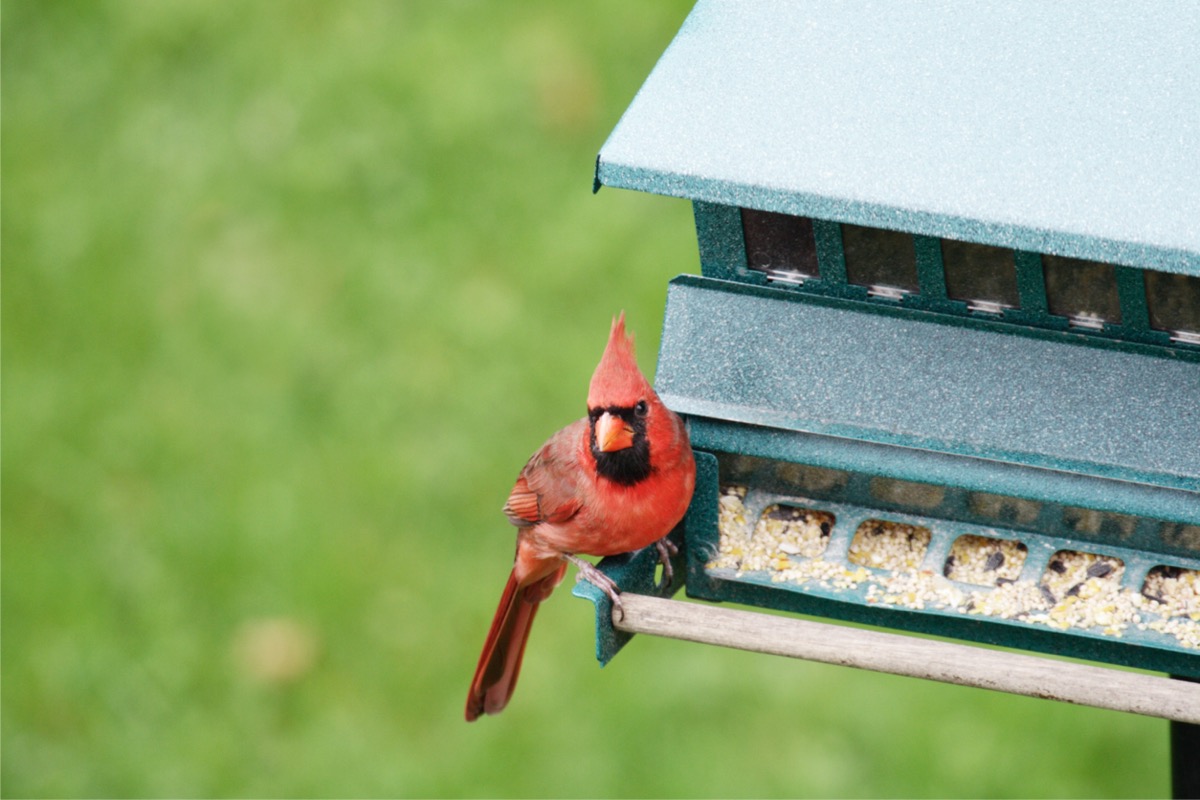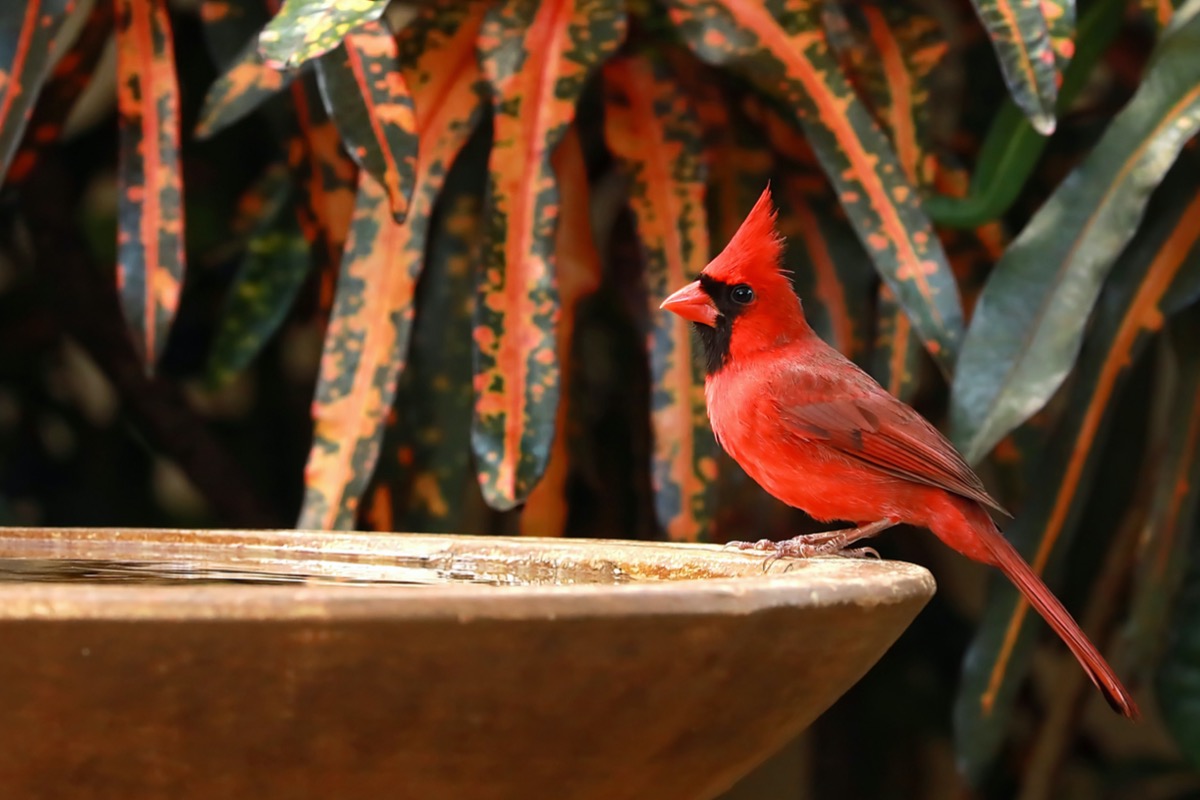

We may earn revenue from the products available on this page and participate in affiliate programs. Learn More ›
During cold, dreary winters in northern climes, many people are thrilled to spot a bright red cardinal in their yard. The cardinal is considered a harbinger of luck and loyalty, so it’s little wonder so many homeowners put forth every effort to entice these colorful birds.
Northern cardinals live primarily in the Northeastern, Midwestern, Southern, Southeastern, and Southwestern regions of the United States, as well as in Mexico and Central America. They can even be found in the southernmost regions of Canada.
Because they don’t migrate, cardinals can be viewed easily in the winter—particularly against a white backdrop of snow. Below are some tips on how to attract cardinals to your backyard.
1. Understand the cardinal diet.

What do cardinals eat? Cardinals are omnivores, with a diet consisting of seeds, fruit, insects, and plant buds. Although around 75 percent of their diet consists of plant material, they also consume bugs during the summer breeding season—particularly soft-bodied insects like caterpillars. If you want to know how to attract cardinals to a bird feeder, consider adding butterfly-hosting plants like dill, fennel, hollyhock, snapdragons, and mustard greens.
2. Bring on the berries.

Male cardinals get their vibrant color primarily from eating berries and fruit rich in carotenoids, such as wild grapes, raspberries, and apples. They also consider dogwood berries a treat.
Planting these types of berry shrubs and fruit trees will attract cardinals to your yard year-round. Low-growing shrubs are best, as the birds like to forage on the ground. In addition to dogwood berries, they like sumac, hackberry, northern bayberry, hawthorn, clematis, mulberry, rose, blueberry, grape, and serviceberry. Growing berries with large seeds provides both the fruit and seed cardinals like.
3. Serve sumptuous seeds.

Cardinals like to eat a variety of things, but seeds are some of their favorite foods. This is evidenced by the downward curve of their beak, which enables them to crack open and crush seeds.
When bugs are scarce in the winter, cardinals can get their protein from black oil sunflower seeds, which also provide extra oils and fats needed for good health. Safflower seeds are another reliable source of oils and carotenoids. Some of cardinals’ other favorite seeds and feeds include peanuts, nyjer (thistle), cracked corn, striped sunflower, and sunflower hearts.
Protein can also come from mealworms and suet, the latter of which is a great source of calories to help them maintain their metabolism all winter.
4. Buy or build fabulous feeders.

The right kind of cardinal food should be put in the right kind of feeder. Our researched guide to the best bird feeders for cardinals offers tips and links to top feeders for attracting the popular birds.
Because they don’t like to turn their bodies to eat, a bird feeder with a platform that allows cardinals to eat while facing forward is one method to attract red cardinals. Also, keep in mind that cardinals have larger jaw muscles than other songbirds and can eat bigger seeds, so make sure the feeder you choose can handle large seeds.
A separate suet feeder can additionally hold two cakes of suet—compressed raw fat studded with seeds, nuts, and berries.
Related: The Best Bird Feeders, Tested and Reviewed
5. Discourage sneaky squirrels.

To keep squirrels from chasing off cardinals (or eating all of their food), it’s wise to invest in a squirrel-proof bird feeder. Options for adapting regular cardinal feeders to be more squirrel-resistant include placing the bird-feeder pole some distance from trees; adding a baffle, cage, or Slinky to impede squirrels from climbing a bird-feeder pole; or adding other types of obstacles to hinder squirrel access. You can also try adding hot pepper to the birdseed. This does not affect birds, but it will discourage squirrels.
There are several attractive options in our researched squirrel-proof bird feeder list that will appeal to cardinals.
6. Provide predator protection.

Because cardinals like the safety of cover, placement of your bird feeder is important. Feeders should be close enough to trees and shrubs to provide protection from predators (but not so near that squirrels have easy access). Cardinals will continue to be attracted to fallen seed under and around a hanging feeder. Ground feeders near shrubbery can provide a sense of security for these redbirds who like to forage. During winter, be sure to brush away snow so they can still get to the seeds.
Related: 10 Garden Plants That Will Feed Backyard Birds in Fall and Winter
7. Incorporate fresh drinking water.

It’s important to provide a consistent source of fresh water, as cardinals need to drink every day. Be sure to keep any bird baths, fountains, or other water containers clean and free of algae and bacteria growth in order to prevent illnesses in birds. Cardinals and other birds are especially drawn to moving water. This also helps to keep the water from freezing, making it an effective way to attract cardinals in winter. Alternatively, you can find solar-powered bird baths that resist freezing without the need for an energy supply.
8. Keep feeders full.

Try to keep your bird feeder(s) filled. Since cardinals don’t migrate in the winter, it’s important to provide a reliable food source for them through the colder seasons. They do most of their foraging late in the day in order to keep warm overnight—as well as first thing in the morning to restore the energy they’ve lost—so make sure feeders are filled in the afternoon to provide them a steady source of nutrition.
Related: The 20 Best Gifts for Bird Lovers
9. Layer your landscape.

Provide protective cover for cardinals by planting evergreen trees or shrubs in your yard. Ideally, plant a selection of shrubs and trees of varying heights to provide shelter and nesting options. Evergreens, in particular, provide year-round cover.
The basic layers of protection these private birds enjoy include large and small trees, large and small shrubs, perennials, and ground cover. These layers not only provide protective shelter but are also a source of nesting materials.
10. Supply natural nesting material.

If you want to encourage cardinals to stick around and start a family in your yard during springtime, offer nesting materials. Cardinals generally don’t use birdhouses, so where do cardinals nest? The most common answer is dense shrubbery. These birds often have more than one brood per year but seldom reuse a nest, so they need a surplus of nesting material. In addition to planting shrubs in your yard to provide them a habitat, you can place things like yarn or pet fur in a suet cage hung near a popular feeder so they can pluck pieces for use in constructing their nests.
